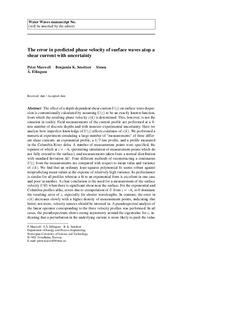The Error in Predicted Phase Velocity of Surface Waves atop a Shear Current with Uncertainty
Journal article, Peer reviewed
Accepted version

Åpne
Permanent lenke
http://hdl.handle.net/11250/2620303Utgivelsesdato
2019Metadata
Vis full innførselSamlinger
Originalversjon
10.1007/s42286-019-00012-xSammendrag
The effect of a depth-dependent shear current U(z) on surface wave dispersion is conventionally calculated by assuming U(z) to be an exactly known function, from which the resulting phase velocity c(k) is determined. This, however, is not the situation in reality. Field measurements of the current profile are performed at a finite number of discrete depths and with nonzero experimental uncertainty. Here we analyse how imperfect knowledge of U(z) affects estimates of c(k). We performed a numerical experiment simulating a large number of “measurements” of three different shear currents: an exponential profile, a 1 / 7-law profile, and a profile measured in the Columbia River delta. A number of measurement points were specified, the topmost of which at z=−hs (permitting simulation of measurement points which do not fully extend to the surface at z=0 ), and measurements taken from a normal distribution with standard deviation ΔU . Four different methods of reconstructing a continuous U(z) from the measurements are compared with respect to mean value and variance of c(k). We find that an ordinary least-squares polynomial fit seems robust against mispredicting mean values at the expense of relatively high variance. Its performance is similar for all profiles, whereas a fit to an exponential form is excellent in one case and poor in another. A clear conclusion is the need for a measurement of the surface velocity U(0) when there is significant shear near the surface. For the exponential and Columbia profiles alike, errors due to extrapolation of U from z=−hs to 0 dominate the resulting error of c, especially for shorter wavelengths. In contrast, the error in c(k) decreases slowly with a higher density of measurement points, indicating that better, not more, velocity measurements should be invested in. A pseudospectral analysis of the linear operator corresponding to the three velocity profiles was performed. In all cases, the pseudospectrum shows strong asymmetry around the eigenvalue for c, indicating that a perturbation in the underlying current is more likely to push c to higher, not lower, values. This is in tentative agreement with our observation that for sufficiently large ΔU , c is found to have predominantly positive skewness, although the direct relationship between the two is not altogether obvious.